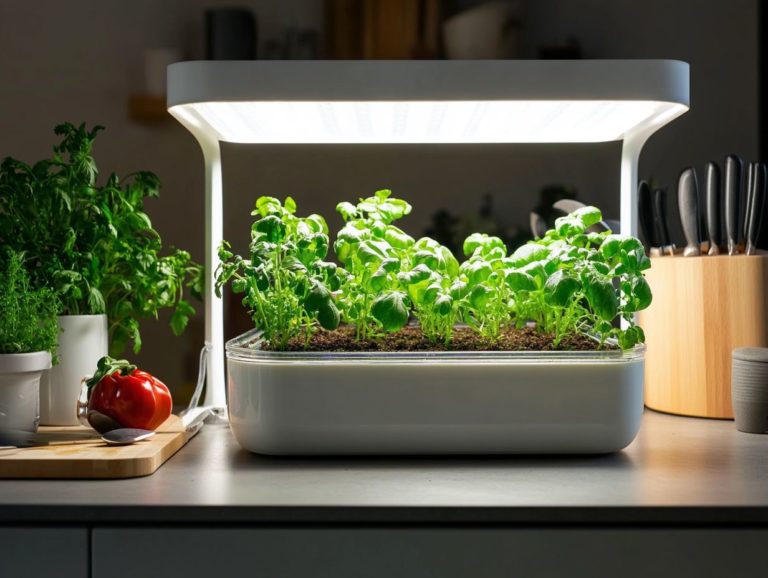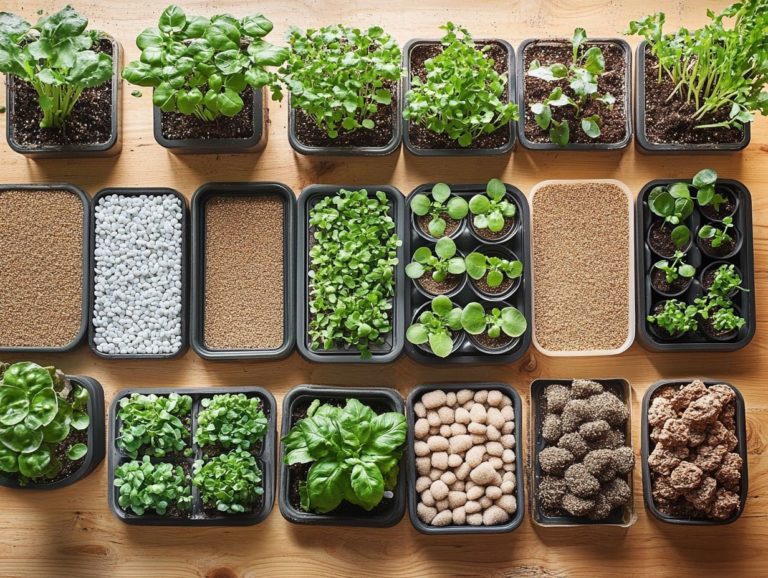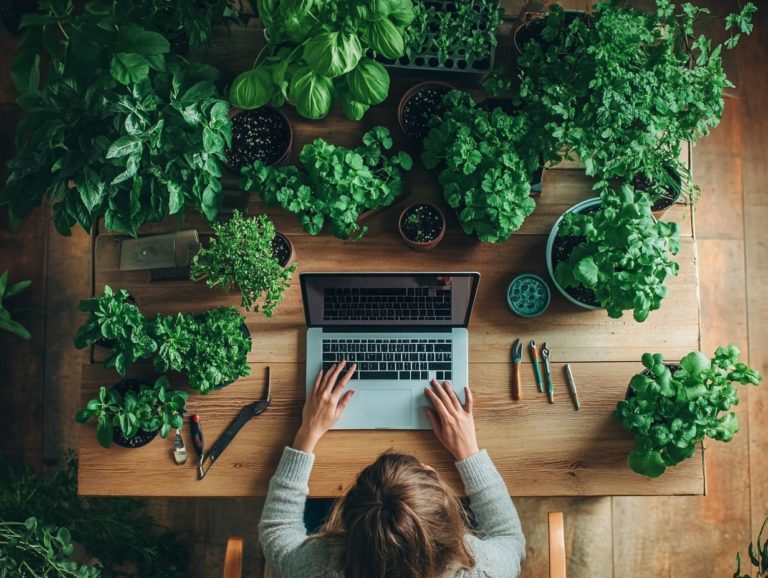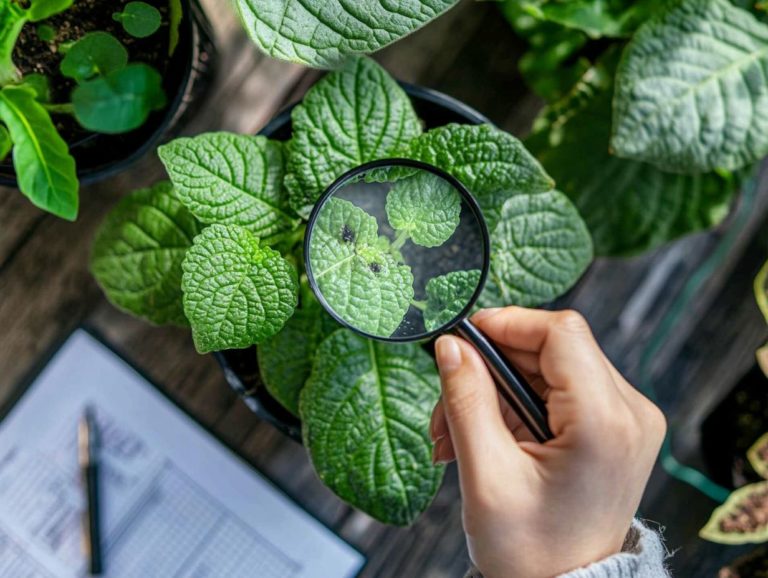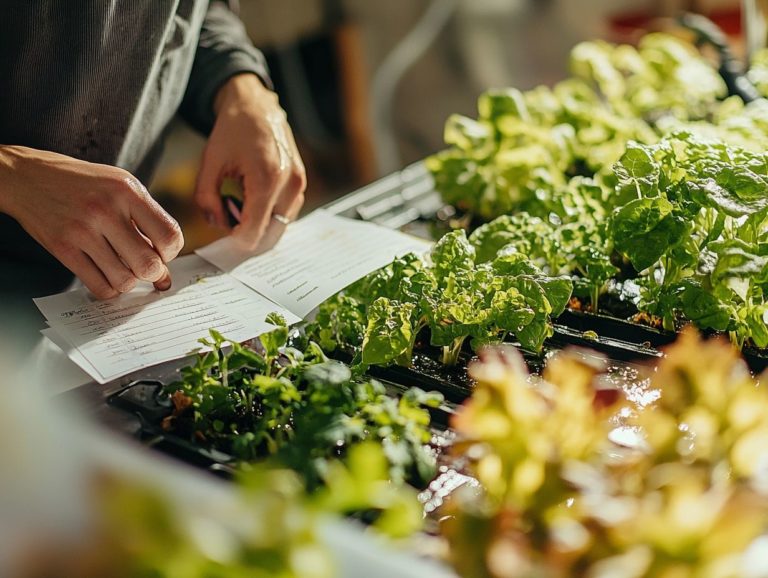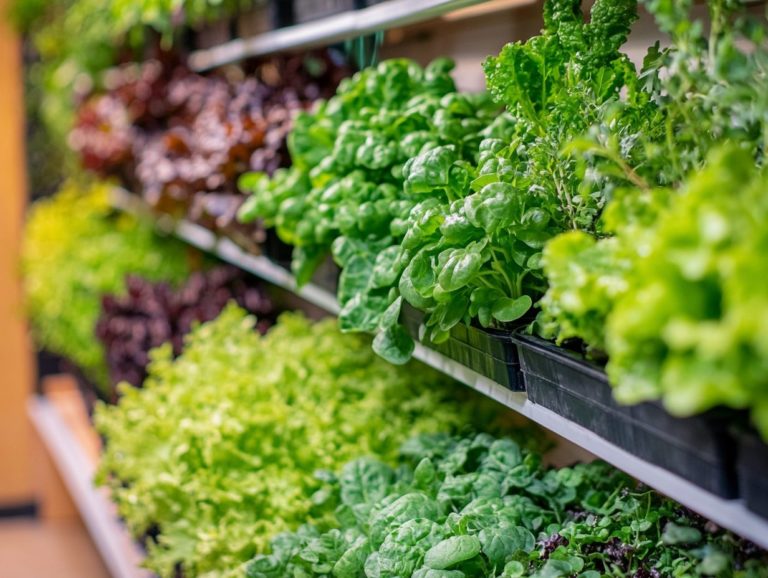What is Vertical Hydroponic Gardening?
Vertical hydroponic gardening is revolutionizing how you grow food by making the most of vertical space and using soilless techniques. This exciting approach lets you use every inch of your space while enhancing efficiency and sustainability.
Discover the many benefits of vertical hydroponic gardening, learn how to set up your own system, and explore which plants thrive best in this unique environment. You will also find essential tips for maintenance and troubleshooting to ensure your garden continues to flourish. Dive in and unlock the full potential of vertical hydroponics!
Contents
- Key Takeaways:
- Benefits of Vertical Hydroponic Gardening
- How to Set Up a Vertical Hydroponic Garden
- Types of Plants that Thrive in Vertical Hydroponic Gardens
- Maintenance and Troubleshooting
- Keeping Your Vertical Hydroponic Garden Healthy
- Frequently Asked Questions
- What is Vertical Hydroponic Gardening?
- How does Vertical Hydroponic Gardening work?
- What are the benefits of Vertical Hydroponic Gardening?
- Can I grow any type of plant using Vertical Hydroponic Gardening?
- Do I need any special equipment for Vertical Hydroponic Gardening?
- Is Vertical Hydroponic Gardening suitable for all environments?
Key Takeaways:
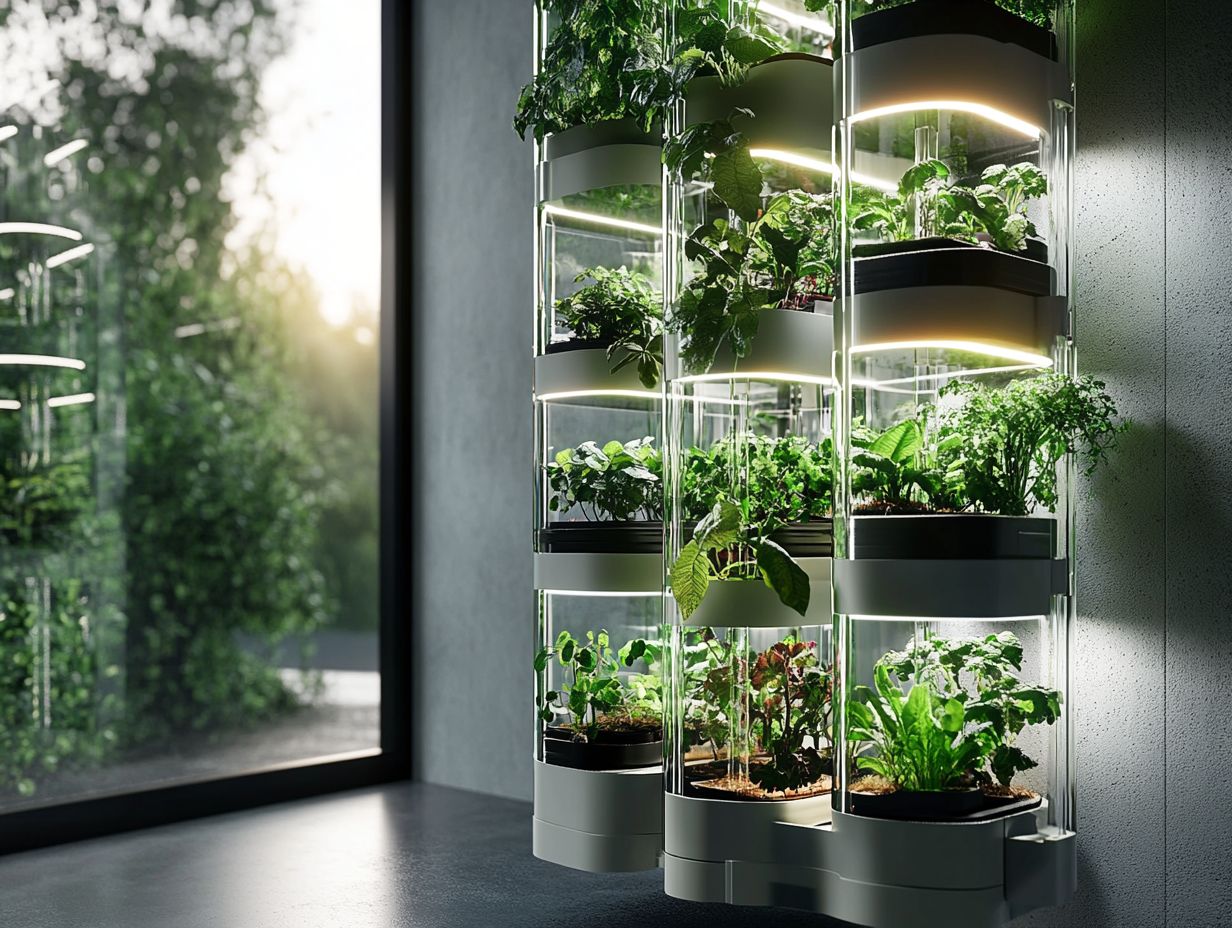
- Vertical hydroponic gardening is a method of growing plants without soil, using a vertical structure and water-based nutrients. This vertical farming method is ideal for indoor gardening and urban centers.
- This type of gardening has many benefits, including space efficiency, water conservation, and the ability to grow a variety of plants all year round.
- To set up a vertical hydroponic garden, you will need equipment and materials such as a grow tower, grow lights, and nutrient solution. Follow a step-by-step guide and choose plants that thrive in this environment for successful growth.
What is Vertical Hydroponic Gardening?
Vertical hydroponic gardening is your gateway to innovative urban agriculture. It allows you to grow crops in a controlled environment without the hassle of traditional soil. By harnessing advanced hydroponic systems, you can take advantage of space-saving designs that optimize plant growth while conserving precious resources.
This sustainable approach recalls the ancient Babylonian Hanging Gardens, merging technology and agriculture to tackle food deserts and overcome agricultural challenges in urban landscapes.
With methods like a thin film of nutrient solution to feed plants, known as nutrient film technique, vertical hydroponics maximizes your crop yields while minimizing environmental impact. The principles behind vertical hydroponics revolve around efficient resource management, ensuring that your plants receive essential nutrients delivered directly to their roots.
In urban settings, vertical hydroponics significantly reduces reliance on arable land and addresses light supply issues with the help of LED grow lights, enabling year-round cultivation. This cutting-edge method dramatically enhances agricultural productivity, making it possible for you to produce food in densely populated areas, thus ensuring both food security and sustainability in a rapidly urbanizing world.
Benefits of Vertical Hydroponic Gardening
Vertical hydroponic gardening presents a wealth of advantages that make it a compelling choice for both urban dwellers and dedicated growers. This innovative method boosts agricultural productivity and champions sustainable practices by employing water-efficient systems and reducing environmental impact, which is crucial for sustainable agriculture.
Its compact design effectively tackles food deserts, ensuring a steady supply of fresh produce in urban areas and diminishing reliance on resource-intensive traditional farming methods. Start your vertical hydroponic garden today and enjoy fresh produce at home!
Advantages over Traditional Gardening
Vertical gardening offers many advantages compared to traditional methods. This is especially true in urban areas where space is limited.
By adopting growing plants without soil, you can achieve impressive crop yields even in compact areas. This approach effectively navigates many of the challenges associated with soil-based farming.
This innovative method optimizes vertical space and promotes healthier plant growth through controlled nutrient solutions and the efficient use of LED grow lights.
This method also creates natural barriers against pests, reducing your need for chemical pesticides a common drawback of conventional gardening.
By opting for soil-less growth, you sidestep soil-borne diseases and streamline the cultivation process, making it cleaner and more efficient.
These techniques empower you to adopt sustainable practices that contribute to food security and foster biodiversity in your urban landscape, helping to maintain the balance of nature.
Environmental Benefits
The environmental benefits of vertical hydroponic gardening are truly remarkable! This groundbreaking method slashes water use dramatically and positions itself as a cornerstone of sustainable urban agriculture initiatives.
It reduces water consumption through efficient recirculation systems, using up to 90% less water than traditional practices. Furthermore, it promotes energy efficiency by cutting down on resources needed for transportation and land use.
By seamlessly integrating into urban settings, these gardens help mitigate heat island effects and nurture a more resilient ecosystem that supports local pollinators while naturally addressing pest control.
You ll find that vertical hydroponic gardening has the potential to dramatically lower carbon footprints. It minimizes reliance on pesticides and fertilizers commonly associated with conventional farming.
Altogether, these advantages contribute to a greener urban landscape while enhancing biodiversity, ensuring that cities can flourish in harmony with nature.
How to Set Up a Vertical Hydroponic Garden
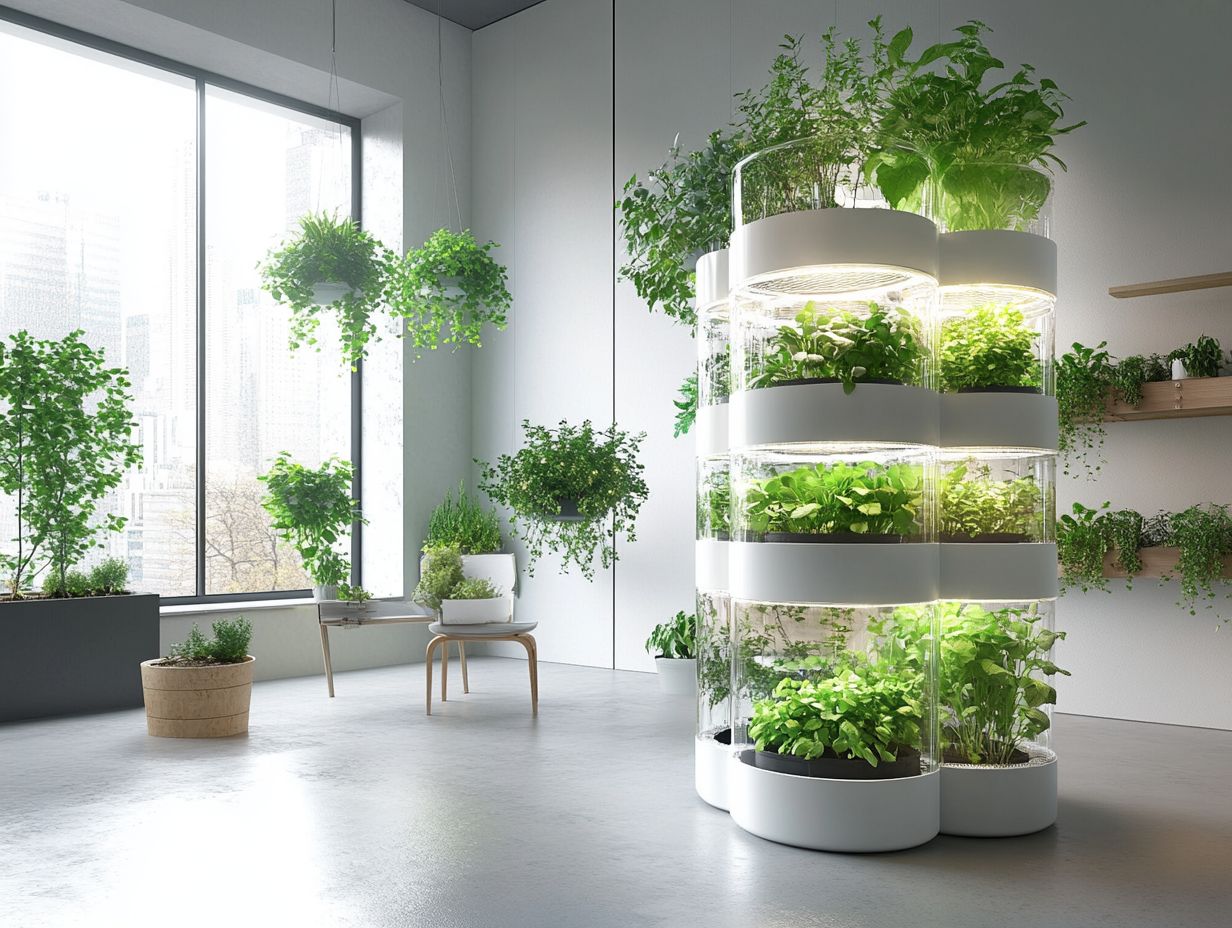
Setting up your vertical hydroponic garden is fun and straightforward! First, pick the right equipment and materials to help your plants thrive.
You ll need essential components like hydroponic systems designed for space-saving vertical layouts, efficient water pumps for optimal water flow, and nutrient solutions tailored to meet the unique requirements of your chosen plants.
This guide will provide a thorough overview of the setup process, ensuring that your garden flourishes in a well-controlled environment.
Equipment and Materials Needed
To start, gather equipment like hydroponic towers and LED grow lights. These are crucial for plant growth.
Next, choose a nutrient solution that meets your plants’ needs. Effective water circulation is also key!
The materials you choose can significantly influence both the efficiency and yield of your garden. For instance, selecting the appropriate type of growing media, such as rock wool or expanded clay pellets, greatly affects root health and nutrient uptake.
Additionally, choosing the correct LED spectrum is crucial for ensuring that your plants receive optimal light for photosynthesis.
Always consider what your plants need to grow strong. Different plants thrive in different environments!
By understanding these elements, you can create a vibrant vertical hydroponic ecosystem that maximizes both space and productivity.
Get started on your vertical garden today and enjoy fresh produce at home!
Step-by-Step Guide
Creating a vertical hydroponic garden involves several essential steps. Begin by selecting the right plants and designing a controlled environment that meets their specific needs.
Your options are extensive. Fast-growing plants like lettuce and aromatic herbs such as basil thrive in these setups. Once you’ve chosen your plants, the next crucial step is to establish a nutrient-rich water solution. This can significantly impact both yield and quality.
After implementing the nutrient film technique, monitor plant growth regularly. Watch for any signs of stress or nutrient deficiency.
Adjust light levels, as different plants have varying light requirements. To ensure effective water circulation, regularly check the pumps and tubing for blockages and leaks. This creates an optimal environment for your plants to flourish.
Types of Plants that Thrive in Vertical Hydroponic Gardens
In vertical hydroponic gardens, various types of plants truly shine. Fast-growing varieties, particularly leafy greens, herbs, and specific vegetables, flourish in the nutrient-rich environment hydroponic systems create.
Understanding which plants are ideally suited for vertical gardening is crucial for maximizing your crop yields and promoting robust growth.
Best Plants for Vertical Hydroponic Gardening
When selecting plants for vertical hydroponic gardening, consider opting for herbs and leafy greens. These fast-growing varieties thrive in a hydroponic environment, adapting seamlessly to vertical farming conditions. Popular choices like basil, lettuce, and kale not only thrive but also deliver impressive crop yields with the right care.
Additionally, think about including Swiss chard and spinach in your garden. These varieties grow beautifully in compact spaces while requiring only moderate light and nutrient levels. Position these plants to receive at least six hours of light each day for optimal growth.
If you re feeling adventurous, integrating crops like strawberries can sweeten your vertical garden. Keep in mind they need slightly higher temperatures and humidity.
The secret to success lies in monitoring pH levels and maintaining a balanced nutrient mix. This ensures any plant you choose can thrive in your hydroponic setup.
Tips for Successful Growth
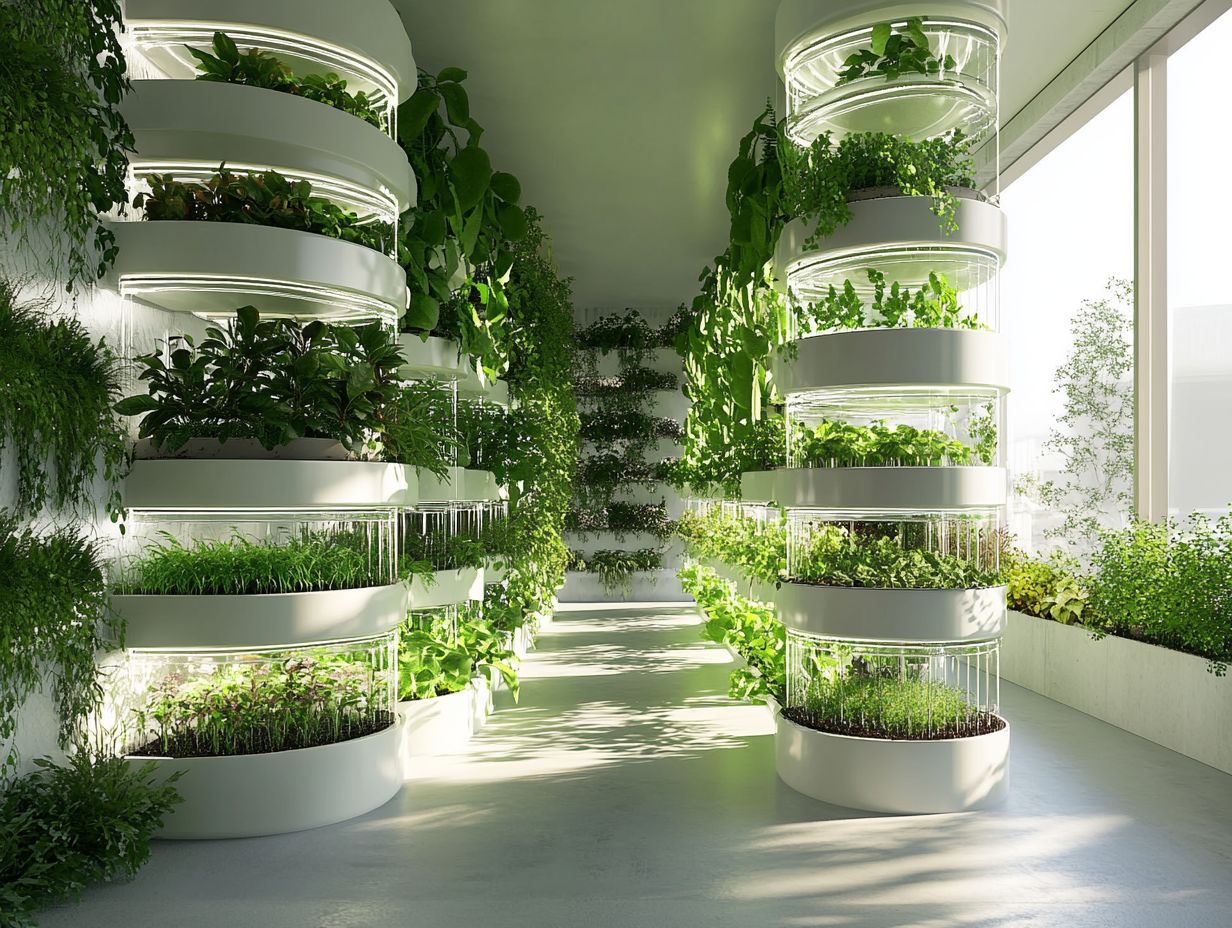
Successful growth in your vertical hydroponic garden hinges on several key factors. Maintaining a controlled environment and addressing common challenges like light supply issues are essential.
Regularly monitor your nutrient mix to ensure it meets your plants’ specific needs. This fosters robust growth. Implement effective pest control measures to safeguard your crops and pave the way for a bountiful harvest.
To fully optimize your plant care, regularly check temperature and humidity levels. These directly influence photosynthesis and overall plant health. Utilizing automated sensors can streamline this process.
Understanding the specific nutrient requirements of each plant type enables you to develop a tailored feeding strategy. This enhances nutrient uptake and growth rates. Establishing a proactive pest management plan including introducing beneficial insects can minimize infestations and reduce reliance on chemical treatments.
Maintenance and Troubleshooting
Regular maintenance and troubleshooting are vital for managing your vertical hydroponic garden. This ensures that your plants flourish and remain sustainable.
Focus on key tasks like monitoring water circulation and adjusting the nutrient solution as needed. Swiftly addressing any issues that arise, whether they are pests or nutrient deficiencies, is crucial.
By staying proactive in these areas, you can maximize your success and cultivate a thriving indoor garden that showcases your dedication and care.
Keeping Your Vertical Hydroponic Garden Healthy
Maintaining the health of your vertical hydroponic garden is essential for maximizing crop yields and tackling agricultural challenges. Act now to monitor your plant food regularly! Ensuring efficient water circulation is fundamental to plant vitality. Implementing effective pest control strategies will protect your crops against potential threats.
To elevate your garden’s performance even further, consider integrating an automated system for nutrient dosing. This technology helps you measure exactly what your plants need for healthy growth! Regularly testing pH levels is also crucial, as even minor fluctuations can hinder nutrient uptake, which means how well plants absorb essential elements.
For optimal water management, employing a timed irrigation system guarantees that your plants receive consistent moisture without the risk of overwatering, which can lead to root rot. Fostering a diverse ecosystem by introducing beneficial insects can deter pests naturally, creating a thriving environment for your hydroponic crops.
Check out this video for a visual guide to vertical hydroponic gardening!
Frequently Asked Questions
What is Vertical Hydroponic Gardening?
Vertical hydroponic gardening is a method of growing plants without soil. Plants are arranged vertically instead of horizontally, allowing for more efficient use of space and making it easier to grow a variety of plants in a small area.
How does Vertical Hydroponic Gardening work?
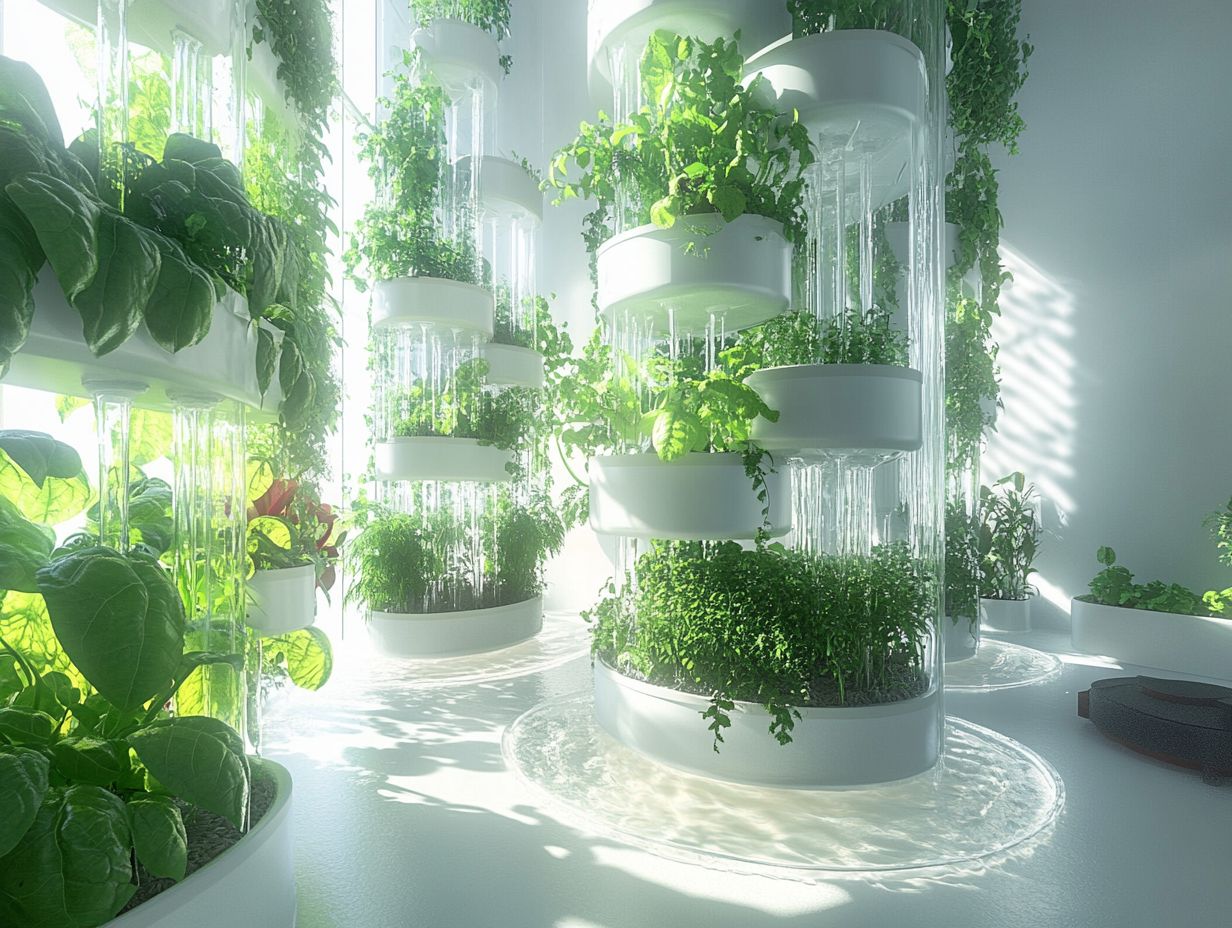
Vertical hydroponic gardening uses a system of pipes, tubes, or towers to deliver water and nutrients to the plants. The plants are suspended in a nutrient-rich solution or growth medium, allowing their roots to absorb the necessary nutrients for growth.
What are the benefits of Vertical Hydroponic Gardening?
Vertical hydroponic gardening has many benefits, including saving space, reducing water usage, and providing a controlled environment for plants to grow. It also eliminates the need for soil, which can contain pests and diseases.
Can I grow any type of plant using Vertical Hydroponic Gardening?
Yes, a wide variety of plants can be grown using vertical hydroponic gardening, including vegetables, herbs, flowers, and even some fruits. However, plants with large root systems may not be suitable for this method.
Do I need any special equipment for Vertical Hydroponic Gardening?
While there are many vertical hydroponic gardening systems available for purchase, it is also possible to create your own using simple materials such as PVC pipes, buckets, and a pump to circulate the nutrient solution.
Is Vertical Hydroponic Gardening suitable for all environments?
Vertical hydroponic gardening can be adapted to suit different environments, but it does require a certain level of control over factors such as light, temperature, and humidity. It may not be suitable for extremely hot or cold climates without proper precautions.

